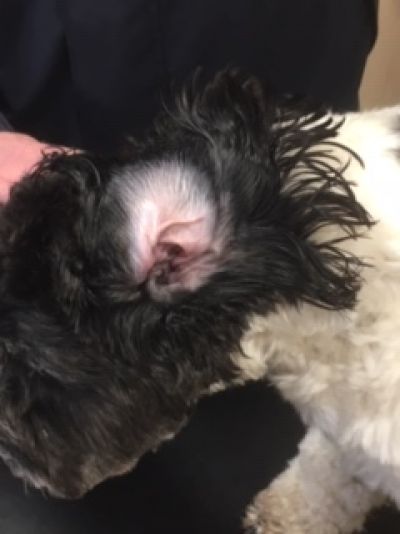
Posted By:
Does your dog get itchy ears? Romeo, pictured here, saw Polly the vet at our Wells practice recently with just that problem, clinically called Otitis Externa. It’s very common in dogs. Sometimes we treat it with antibiotics, but in fact that is far from the first line of treatment.
Primary infections in the ears in dogs are actually quite unusual. We sometimes see ear mites (Otodectes cynotis) in young puppies, and this is intensely itchy. Fortunately, ear mites are easily treated nowadays with some of the prescription flea treatments that we stock at our surgeries. They rarely affect healthy, adult dogs.
Bacterial and fungal “infections” are generally better described as an overgrowth of some of the micro-organisms found normally in dogs’ ears. We all have a mixed population of bacteria and yeasts on our skin and in our ears which live in harmony with us and can actually be of benefit. But when the normal environment of the ear changes, some of these microbes can reproduce faster than others, resulting in altered balance and damage to the ear.
Wild dogs have ears that stand up, with little hair inside the ear and none in the ear canal itself. This allows fresh air to circulate in the ear, providing oxygen and keeping the ear dry and cool. Compare that to the variety of ears we see in pet dogs. Dogs like spaniels have ears that flop down, covering the ear canal’s entrance. Poodles and bichon frises have curly hair growing right down the ear canals. And if you cross a spaniel with a poodle, you get both (think cockerpoos!) A lack of fresh air means the ear canals become warmer and more humid than those of prick-eared dogs, and most micro-organisms like it warm and damp, especially fungi or yeasts. It also means reduced oxygen flow, so anaerobic bacteria get the advantage over the other microbes and proliferate.
A fair number of pet dogs also have allergic skin disease nowadays. Some of these are seasonal, a bit like hay fever in people; and some are all year round. These dogs get areas of itchy, inflamed skin, like eczema, and the ears are often affected. That means warmer ears, which are often swollen too, so the ear canal gets narrower, and guess what? Reduced air flow.
There are steps owners can follow at home to deal with many of these factors.
For floppy or hairy- eared dogs, keep the hair inside the ear flap and around the ear canal clipped short. Your dog groomer can do this, or you could do it yourself using appropriate small, quiet electric clippers. We did this with Romeo and you wouldn’t see the difference when his ears hang down. There’s currently some debate as to whether plucking hair out of the ear canal itself helps; talk to your vet about this as we can have a good look down your dog’s ears with an otoscope and decide what’s best for that individual.
Dry your dog’s ears well with a towel after wet walks or swimming. Just the outside and the ear flap – don’t ever push anything down the ear.
If your dog has allergic skin disease, work with your vet to keep this as controlled as possible, and remember to pre-empt flare ups during the summer when the pollen count is high.
In dogs that have had more than one episode of otitis externa, research has shown that cleaning the ears twice weekly as a routine will reduce recurrence. Use a liquid ear cleaner and get a veterinary nurse to show you how to do it safely and effectively. Ear cleaning has a number of benefits. Firstly, it removes debris and wax which might be obstructing the ear canal and reducing air flow. Secondly, it reduces the sheer number of micro-organisms in the ear, making overgrowth less likely. Thirdly, it gives you, the owner, and early warning system of trouble brewing.
Signs of ear problems include shaking the head; holding one or other ear down; not wanting the head touched or the ears cleaned; discharge or excessive wax in the ears; redness; and bad smells from the ears. If your dog shows any sign or ear inflammation, make an appointment to see the vet as soon as possible. We need to look right down into the ear to find out what is going on and treat it appropriately. Ear problems are often much quicker and easier to treat if we see them early on, and if left they can be very painful, and may lead to permanent damage to the ears.
Happily, Romeo’s ears are back to their normal, fresh, clean selves now; and with home management, long may that last.
As our feline friends get older there are a few conditions...
Another winter discussion group season is now behind...
We used a client’s new Morris Remote Control...
©2024 Shepton Veterinary Group Ltd., All rights reserved.
Privacy Policy • Terms & Conditions • Cookie Policy